Research

As our laboratory framework, we investigate various features in agroecosystems that influence insect pest populations and beneficial insects from individual plants within fields to the landscape with an ultimate goal of increasing crop yields, fruit quality, and grower profitability.
This objective is achieved through research on:
-
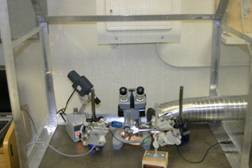
Electro-antennographic (EAG)
detection apparatus for the identification of antennally-active plant volatilesPlants emit volatiles that can serve as important cues for insect herbivores in host and mate finding. These volatiles can be used as attractants for monitoring and managing insect pests. We have established a laboratory for the study of plant volatiles and insect behavior at the Rutgers P.E. Marucci Center. This laboratory accommodates equipment for the collection and analyses of plant volatiles, electro-antennographic detection, and insect’s behavioral response to plant volatiles.
-
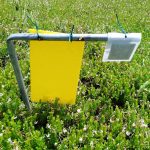
Traps Baited with Host-Plant Predator Attractants Beneficial insects such as natural enemies of herbivorous insects (predators and parasitoids) and pollinators use volatile cues from plants in host finding. These volatile cues are often induced by herbivore feeding. We are studying the above- and below-ground volatile emissions in blueberry and cranberry plants and their effects on foraging natural enemies.
-
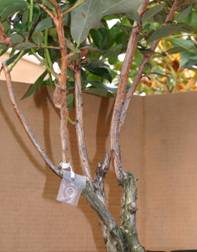
Retrievable pheromone dispenser Our team is conducting studies towards the development and implementation of behavior-based strategies for pest control such as mating disruption, attract-and-kill, and push-pull technologies. Examples include mating disruption for oriental beetle management and attract-and-kill and push-pull technologies for spotted wing drosophila control.
-
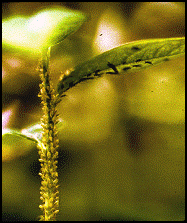
Blueberry aphids transmit
blueberry scorch virusPlants produce secondary compounds that provide protection against insect herbivores. In addition, plants may respond to insect feeding damage by inducing defenses that reduce the performance and preference of the insect herbivores. Our team is studying constitutive and inducible resistance in the perennial blueberries and cranberries.
-
The transition to selective reduced-risk
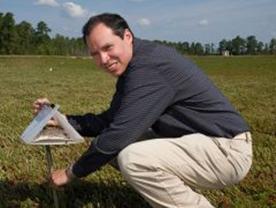 insecticides will require the development of new monitoring practices for a better understanding on the seasonal population fluctuations of blueberry and cranberry insect pests and for a more precise timing of chemical applications. We are studying the interactive roles of visual and chemical cues in insect host finding to develop better monitoring tools. We use Geographic Information System (GIS) technologies to better understand pest movement and distribution.
insecticides will require the development of new monitoring practices for a better understanding on the seasonal population fluctuations of blueberry and cranberry insect pests and for a more precise timing of chemical applications. We are studying the interactive roles of visual and chemical cues in insect host finding to develop better monitoring tools. We use Geographic Information System (GIS) technologies to better understand pest movement and distribution. -
After the Food Quality Protection Act (FQPA) was implemented in 1996, several broad-spectrum insecticides have been under review, scheduled for cancellation, or severely restricted for use in blueberries and cranberries due to potential surface water pollution, negative effects on wildlife, and worker exposure. It is critical that new selective, reduced-risk insect management strategies become available to blueberry and cranberry growers. Our team evaluates new reduced-risk insecticides for the control of various blueberry and cranberry insect pests.